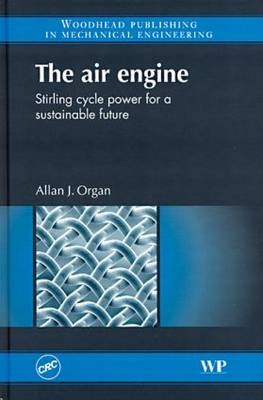
The Air Engine
Crc Press Inc (Verlag)
978-1-4200-6672-2 (ISBN)
- Titel ist leider vergriffen;
keine Neuauflage - Artikel merken
Two centuries after its original invention, the Stirling engine has finally emerged as a commercial reality. Providing an alternative to centralized power generation, the Stirling is now employed as the core component in domestic CHP (combined heat and power) technology, which offers substantial savings in raw energy utilization and in doing so also addresses current concerns regarding hydrocarbon consumption and greenhouse gas emissions. The successful use of the Stirling requires the addressing of a range of issues, including the long-standing mismatch between inherently favorable internal efficiency and wasteful external heating provision; the dearth of data on heat transfer and flow related to the task of first-principles design; and its limited RPM capability when operating with air (and nitrogen) as working fluids. All of these matters are explored in depth in The Air Engine: Stirling Cycle Power for a Sustainable Future. The account also includes previously unpublished insights into the character and potential deployment of two related engines -- the pressure-wave and thermal-lag.
Regenerative Thermal Machines, UK
Introduction
- An invention ahead of its time
- Full-steam ahead
- …after the horse had bolted
- Where does the air engine fit in? A second industrial evolution
- Domestic CHP and the air engine
PART 1 A LONG-OVERDUE RE-APPRAISAL
The famous engine that never was
- Status quo
- The legend
- History reconstructed
- Exploratory firing tests
- Reassessment
- Post script
What Carnot efficiency?
- Ideal cycle – or perfect alibi? What Carnot efficiency? Old heat exchanger, new air pre-heater
- Resources for first-principles gas path design
- A further take on friction factor Cf – and not the last
- Beyond the sound barrier
- Geometric descriptors for the wire matrix
- Inconsistencies uncovered
- Résumé
The counter-flow spiral heat exchanger – Spirex
- Heat provision as an integral part of the engine system
- Thermal analysis
- Heat transfer and flow friction correlations
- Special case of high NTU
- Numerical integration
- Specimen solutions
- Discussion
A high-recovery-ratio combustion chamber
- The design problem
- Principle
- Operation
- Materials
- Preliminary operating experience
- Second design interation
PART 2 LIVING WITH INCOMPRESSIBLE FLOW DATA
The regenerator problem brought down to size
- Background
- Assumptions
- Defining equations
- Boundary conditions
- Flush ratio
- Integration algorithm
- Specimen temperature profiles
- Design criterion for NTCR
- Alternative formulation in corroboration
- Conclusions
The regenerative annulus and shuttle heat transfer
- Introduction
- Background
- Reformulation
- Assumptions
- Analysis
- Cyclic shuttle heat transfer loss
The rotating-displacer air engine
- Résumé
- An alternative
- Taylor parameter
- A rotating-displacer air engine
- Academic design exercise
The strange case of the self-regulating air engine
- Background
- Some realities
- Constructional details
- Exploratory power and torque measurement
- 'Self-regulation'
- Tentative explanation
- Conclusions
Some light on the inner workings of the thermal lag engine
- The concept
- 'Thermal lag' engine
- Ideal gas process sequence
- A detailed model of the thermal processes
- Limited heat transfer
- Flow losses
- A practical thermal lag engine
- Preliminary operating experience
- After-thought
PART 3 WORKING WITH THE REALITY OF COMPRESSIBLE FLOW
New correlations for old
- Right data – wrong application
- The misleading Cf – Re correlation
- Flow data acknowledging Ma
- Dynamic Similarity to the rescue
- Farewell to friction factor
- The new format
- What the new format reveals about 'incompressible' flow data
- Epitaph
Regenerator thermal analysis – un-finished business
- Regenerator design in context
- Assumptions
- Modified diffusion law
- Numerical solution
- Parameters of operation
- Pressure and velocity fields
- Inevitable asymmetry of flow cycle
- Anisotropic matrix
- Discussion
Flow passage geometry
- Scope
- Symmetrical gauze – flow perpendicular to plane of weave
- Flow parallel to plane of weave
- Commercial availability
- Specimen isotropic material – metal foam
Beyond the performance envelope
- Introduction
- Method of Characteristics
- 'Unit process' of the integration sequence
- High-speed operation – the pressure-wave engine
- Discussion
For the skeptics
- What does it all add up to? Flow in the isolated gauze aperture
- Defining equations
- Radial component of kinetic energy
- The not-so-square-weave wire gauze
- Kinetic energy of rotation
- 'Real' (van der Waals) gas
- Downstream pressure recovery
- Simulated correlation p/p = p/p{Sg, Ma, y, dwmw.}
- Implications for first-principles design
- Résumé
PART 4 SOME DESIGN CONSIDERATIONS
Scaling - and the neglected art of back-of-the-envelope calculation
- The overriding objective
- Gas path scaling – update
- Back-of-the-envelope Ma and Re in the regenerator
- Limiting Ma
- Compressibility vulnerability chart
- Heat transfer
- Implications for back-of-envelope design
- A 'screening' test
- The wider rôle of scaling
'How to make a business out of Stirling engines today'
- Tribal wisdom
- From alchemy to appropriate technology
- What else has changed? The VDF-750(aS)
- Drive mechanism/kinematics
- General mechanical construction
- Pressure balance seal
- Beyond 2006
APPENDICES
Appendix I Draft patent specification- What I claim is …
- AbstractAppendix II Crank mechanism kinematics
- Algebra of kinematics of high-compression crank mechanismAppendix III Equilibrium or 'temperature-determined' picture of thermal lag engine
Appendix IV Tribal wisdom
| Erscheint lt. Verlag | 1.12.2007 |
|---|---|
| Verlagsort | Bosa Roca |
| Sprache | englisch |
| Maße | 156 x 235 mm |
| Gewicht | 567 g |
| Themenwelt | Technik ► Bauwesen |
| Technik ► Elektrotechnik / Energietechnik | |
| ISBN-10 | 1-4200-6672-2 / 1420066722 |
| ISBN-13 | 978-1-4200-6672-2 / 9781420066722 |
| Zustand | Neuware |
| Haben Sie eine Frage zum Produkt? |
aus dem Bereich


